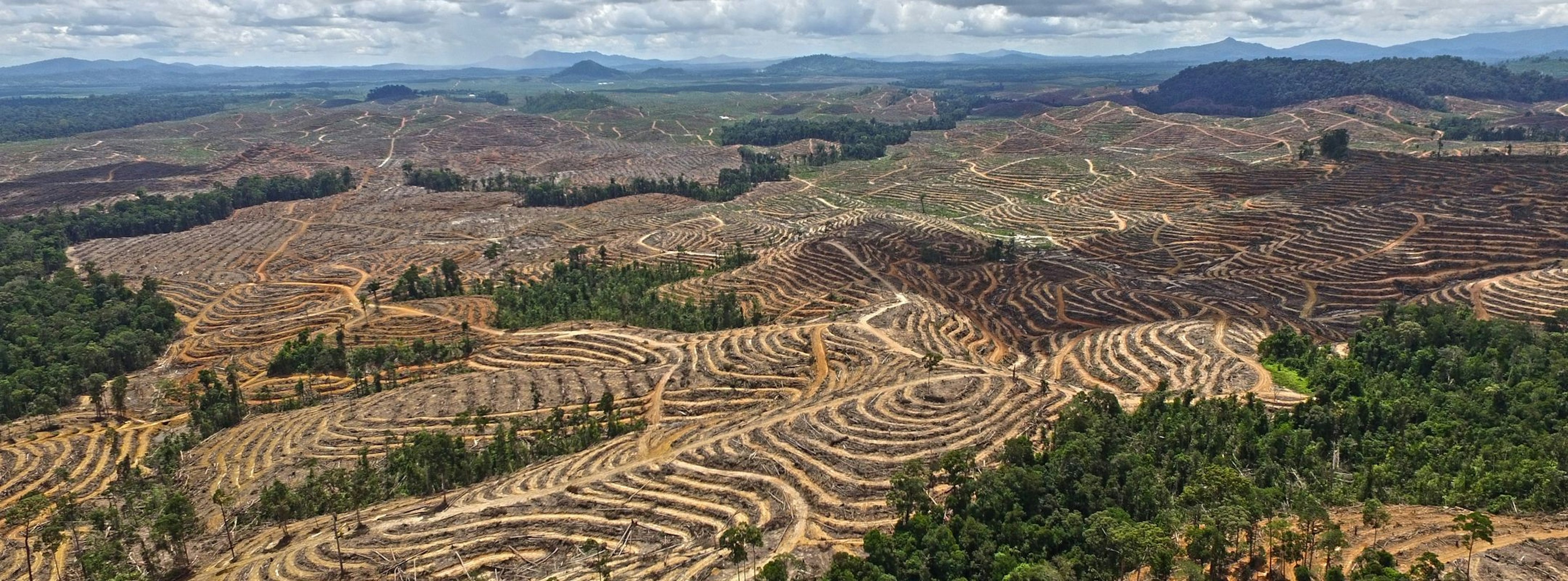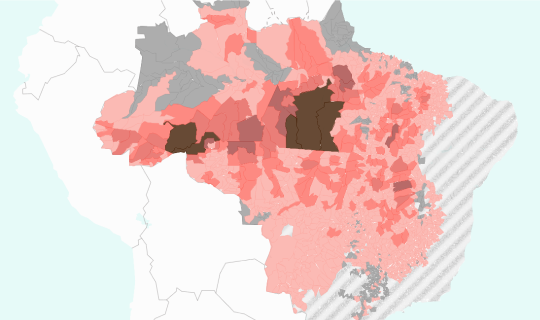In 2021, Indonesia produced 46 million tonnes of crude palm oil, making it the world’s largest palm oil producer. The palm oil industry has grown to become an important part of Indonesia’s economy, representing 4.5% of GDP and lifting millions of Indonesians out of poverty. Much of this growth has been fuelled by international demand for palm oil products. Indonesia is the world’s largest exporter of crude and refined palm oil, exporting over 58% of its production and contributing 59% of total global exports.
Declining deforestation despite growth in production
The expansion of oil palm plantations has been an important driver of deforestation in Indonesia for the past 20 years, accounting for one third (3 million hectares) of Indonesia’s loss of old-growth forest. This deforestation, alongside peatland drying and associated fires, is an important contributor to global climate change and biodiversity loss, as well as poor local air quality. Because many of Indonesia’s current palm oil supply chains start with production on recently deforested lands, every 1,000 tonnes of palm oil produced in 2020 was associated with an average of 3.24 hectares of deforestation risk ranging from zero hectares per 1,000 tonnes for the best performing 10% of production, to 18.2 hectares per 1,000 tonnes for the worst performing 10% of production.
However, Indonesia has achieved a remarkable reversal in deforestation trends, including deforestation for palm oil production. In 2018-2020, deforestation for palm oil was 45,285 hectares per year – only 18% of its peak in 2008-2012. Importantly, deforestation has fallen during a period of continued expansion of palm oil production. Although the decline in deforestation has been linked to a drop in the market value of crude palm oil, the recent spike in palm oil prices has not yet been accompanied by a boom in palm-driven deforestation – a cause for cautious optimism.
Despite declining rates of deforestation, 2.4 million hectares of intact forest remains within Indonesia’s oil palm concessions. This large area of forest designated for palm oil production underscores both an opportunity for conservation, as well as the potential risk that further oil palm expansion may pose to Indonesia’s rainforest. A fundamental challenge over the coming decade will be to meet continued growth in demand for products derived from palm oil, while ensuring that deforestation continues to decline.
Recent deforestation concentrated in Kalimantan and Papua
Although deforestation has generally declined across Indonesia over the past decade, several provinces continue to see significant conversion of forests to oil palm plantations. In recent years, deforestation for palm oil production has been concentrated in the forest-rich provinces of Indonesian Borneo and Papua. Together, these two islands accounted for 77% of all deforestation for palm oil in Indonesia in 2018-2020.
Importantly, palm oil produced in the province of Papua experienced a 24% increase in its deforestation risk, stemming from a near doubling of its palm oil production between 2018 and 2020. Since 2010, oil palm plantation companies are increasingly investing in the development of plantations and mills in Papua, while the Indonesian government has invested in ambitious road construction programmes to facilitate land development. While the number of mills operating in Papua province increased from 4 to 11 between 2015 and 2020, the province currently only contains 1% of Indonesia’s mill capacity. If Papua were to expand the number of mills and follow Kalimantan’s past trajectory, an estimated 4.5 million hectares (Mha) – around 13% of the total 34.29 Mha of forest – could be converted to oil palm and other plantations by 2036.
Company commitments and transparency
Indonesia’s palm oil sector is notable for its widespread adoption of zero-deforestation commitments (ZDCs) – more than 85% of palm oil exports are traded by companies with formal ZDCs. However, in the first few years after these commitments were adopted, supply chains governed by ZDCs had a relatively similar deforestation risk to the broader sector.
In the years since, companies have more fully implemented their commitments and begun to publicly disclose information about their supply chains. In 2018-2020, 87% of refined palm oil exports were sourced from refineries that publicly reported on the set of mills from which they purchased crude palm oil. By integrating these lists into the Trase model of supply chains, we are able to provide the most rigorous analysis yet comparing the environmental performance of exporters who have adopted ZDCs to those who have not.
Overall, we find important differences in deforestation across these two supply chains. Exporters with ZDCs are now sourcing palm oil from supply chains with lower rates of deforestation for palm oil (see figure below). Similarly, each tonne of palm oil exported by traders with ZDCs had only 70% of the deforestation risk of a comparable tonne of palm oil exported by other traders. Together, these results provide evidence of a differentiated market in which supply chains governed by ZDCs have a markedly lower rate of deforestation.
Domestic demand grows for Indonesian palm oil
Since 2013, India, China and the European Union (EU) have been Indonesia’s largest palm oil export markets, together purchasing 49% of 2013-2020 exports. However, the relative importance of each of these markets has changed. In 2013, India (29% of exports) and the EU (17% of exports) were the biggest importers of Indonesian palm oil. By 2020, exports to India (16%) and the EU (12%) had declined, and China had become the largest importer of Indonesian palm oil, increasing its market share from 11% of exports in 2013 to 16% in 2020.
Importantly, Indonesian palm oil is increasingly used within Indonesia. Domestic use of palm oil for either local consumption or downstream manufacturing increased from 32% of production in 2018 to 40% in 2020. Data from the Indonesian Palm Oil Association (known locally as GAPKI) shows that in 2020, over half of the domestically consumed palm oil was used for the biodiesel and oleochemical industry with the remainder used in food products.
The Indonesian government’s efforts to expand domestic production and use of biodiesel has been one driver of this growth in domestic demand, and has been seen as a possible reason behind the supply shortage and increased prices of cooking oil that plagued Indonesia in late 2021 and early 2022. Note that, although 30% of biodiesel and oleochemical production is exported, Trase categorises all downstream Indonesian processing as “domestic processing/consumption”.
In addition to being the largest markets for Indonesian palm oil, Indonesia, China and India all tend to source from supply chains with comparatively higher rates of deforestation risk. We estimate that these markets tend to rely on palm oil with 2.4 times the per-tonne deforestation risk of exports destined for export to the EU.
The combination of large volumes and a relatively high rate of deforestation risk means that the combined palm oil purchases of these three countries cover 61% of all of Indonesia’s deforestation risk. In contrast, although 97% of palm oil flowing to the US, EU and UK is exported by groups with zero-deforestation commitments, these markets bought only 9% of Indonesian palm oil production in 2020.
Indonesia-based groups among fastest growing exporters
Indonesia’s export market has been consistently dominated by four exporter groups: Wilmar, Sinar Mas, Musim Mas and Royal Golden Eagle. However, since 2015, their combined share of 68% of palm oil exports has declined to 59% of total exports in 2020. Only Royal Golden Eagle has expanded its share of exports during this period. This declining market concentration is, in part, due to new entrants in the sector – the number of corporate groups exporting from Indonesia has increased 24% between 2018 and 2020.
Several historically smaller, Indonesia-based companies including KPN Corp, Astra Agro Lestari and Citra Borneo Indah (CBI) are among the fastest growing palm oil exporters, growing from less than 5% of exports in 2018 to more than 10% in 2020. These three companies have specialised in exporting to markets in Asia and Africa, with more than 98% of their 2020 exports destined for these markets. These three exporters are also the only corporate groups among Indonesia’s top 12 exporter groups that did not release traceability reports in 2020. Despite all having adopted zero-deforestation commitments, the average tonne of palm oil exported by these groups has a deforestation risk that is 1.7 times as large as the average of all other palm oil exports.
The authors thank the incredible community of researchers who have contributed to this research. In particular, this analysis wouldn’t have been possible without important contributions from Helen Bellfield, Kim Carlson, Ramada Febrian, Toby Gardner, David Gaveau, Timer Manurung, Vivian Ribeiro, Clément Suavet and Dedy Sukmara.
To reference this article, please use the following citation: Heilmayr, R., & Benedict, J. (2022). Indonesia makes progress towards zero palm oil deforestation. Trase. https://doi.org/10.48650/50NG-RT71
Trase. (2022). SEI-PCS Indonesia palm oil v1.2 supply chain map: Data sources and methods. Trase. https://doi.org/10.48650/ZY8Z-F795
Was this article useful?





